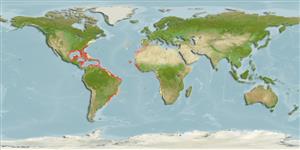Common names from other countries
Environment: milieu / climate zone / depth range / distribution range
Écologie
marin récifal; profondeur 2 - 275 m (Ref. 4727), usually 3 - 30 m (Ref. 40849). Tropical; ? - 28°C; 43°N - 35°S, 98°W - 14°E
Western and Eastern Atlantic.
Length at first maturity / Taille / Poids / Âge
Maturity: Lm 23.5 range ? - ? cm
Max length : 60.0 cm TL mâle / non sexé; (Ref. 7251); common length : 30.0 cm TL mâle / non sexé; (Ref. 5217); poids max. publié: 5.4 kg (Ref. 4699); âge max. reporté: 14 années (Ref. 128045)
Épines dorsales (Total): 3; Rayons mous dorsaux (Total): 29-32; Épines anales 0; Rayons mous anaux: 27 - 29. Greenish or bluish gray on back, orange-yellow on lower part of head and abdomen, with two broad diagonal curved bright blue bands running from snout to below and in front of pectoral fins, the lowermost continuous with a blue ring around lips; a broad blue bar across caudal peduncle, and blue sub-marginal bands in median fins (Ref. 13442).
Found over rocky or coral areas (Ref. 5217). May form schools, sometimes solitary over sand and grassy areas. Feeds mainly on benthic invertebrates (Ref. 4727). It preys on sea urchins by blowing water to overturn it and then attacks it where the spines are short (Ref. 9710). Excellent food fish but occasionally can cause intoxication due to the liver.
Robins, C.R. and G.C. Ray, 1986. A field guide to Atlantic coast fishes of North America. Houghton Mifflin Company, Boston, U.S.A. 354 p. (Ref. 7251)
Statut dans la liste rouge de l'IUCN (Ref. 130435)
CITES (Ref. 128078)
Not Evaluated
Menace pour l'homme
Poisonous to eat
Utilisations par l'homme
Pêcheries: intérêt commercial mineur; pêche sportive: oui; Aquarium: Commercial
Plus d'informations
RéférencesAquacultureProfil d'aquacultureSouchesGénétiqueElectrophoresesHéritabilitéPathologiesTraitementMass conversion
Outils
Articles particuliers
Télécharger en XML
Sources Internet
Estimates based on models
Preferred temperature (Ref.
115969): 22.5 - 28, mean 25.9 (based on 694 cells).
Phylogenetic diversity index (Ref.
82804): PD
50 = 0.5078 [Uniqueness, from 0.5 = low to 2.0 = high].
Bayesian length-weight: a=0.02818 (0.02342 - 0.03391), b=2.94 (2.89 - 2.99), in cm Total Length, based on LWR estimates for this species (Ref.
93245).
Niveau trophique (Ref.
69278): 3.8 ±0.1 se; based on diet studies.
Résilience (Ref.
120179): Milieu, temps minimum de doublement de population : 1,4 à 4,4 années (K=0.15-0.57).
Fishing Vulnerability (Ref.
59153): Moderate to high vulnerability (54 of 100).
